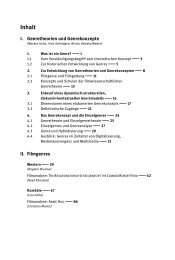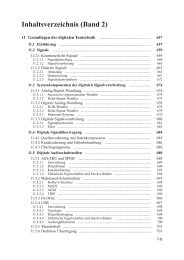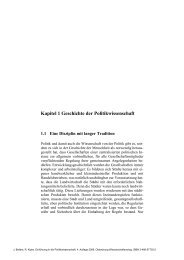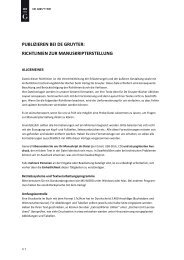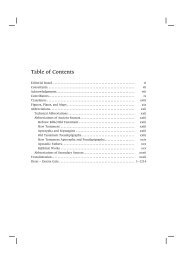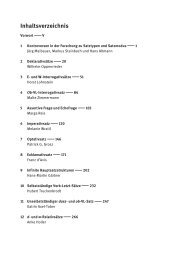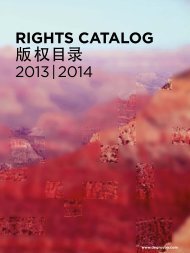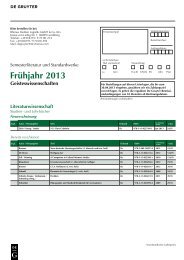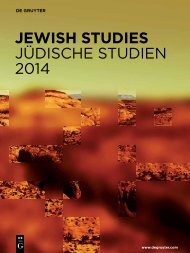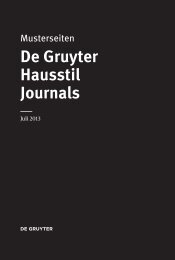Corpus inscriptionum Iudaeae/Palaestinae (CIIP) - Walter de Gruyter
Corpus inscriptionum Iudaeae/Palaestinae (CIIP) - Walter de Gruyter
Corpus inscriptionum Iudaeae/Palaestinae (CIIP) - Walter de Gruyter
Sie wollen auch ein ePaper? Erhöhen Sie die Reichweite Ihrer Titel.
YUMPU macht aus Druck-PDFs automatisch weboptimierte ePaper, die Google liebt.
<strong>Corpus</strong> <strong>inscriptionum</strong> Latinarum<br />
<strong>Corpus</strong> <strong>inscriptionum</strong> Latinarum<br />
Herausgegeben von <strong>de</strong>r Berlin-Bran<strong>de</strong>nburgischen Aka<strong>de</strong>mie <strong>de</strong>r Wissenschaften<br />
(und ihren Vorgänger-Institutionen)<br />
Unter <strong>de</strong>r Leitung von Theodor Mommsen wur<strong>de</strong><br />
1853 das <strong>Corpus</strong> Inscriptionum Latinarum<br />
(CIL) gegrün<strong>de</strong>t. Bis zum Ersten Weltkrieg war<br />
bereits <strong>de</strong>r größte Teil <strong>de</strong>r damals bekannten<br />
lateinischen Inschriften antiker Provenienz publiziert.<br />
Diese Leistung, die von Mommsen,<br />
später insbeson<strong>de</strong>re von seinen Schülern in Verbindung<br />
mit Wissenschaftlern aus <strong>de</strong>n Fundlän<strong>de</strong>rn<br />
erbracht wur<strong>de</strong>, fand internationale Anerkennung.<br />
Seit<strong>de</strong>m ist das <strong>Corpus</strong> die maßgebliche<br />
Dokumentation <strong>de</strong>s epigraphischen Erbes<br />
<strong>de</strong>r römischen Antike. Für die Erforschung <strong>de</strong>r<br />
römischen Lebenswelt und Geschichte ist es unentbehrlich.<br />
Das CIL erfasst die lateinischen Inschriften aus<br />
<strong>de</strong>m gesamten Raum <strong>de</strong>s ehemaligen Imperium<br />
Romanum in geographischer und systematischer<br />
Ordnung. Die Edition beruht auf <strong>de</strong>r<br />
Autopsie <strong>de</strong>r Inschriften unter Berücksichtigung<br />
<strong>de</strong>r handschriftlichen und <strong>de</strong>r gedruckten<br />
Überlieferungen. Neufun<strong>de</strong> und Korrekturen<br />
bereits veröffentlichter Inschriften wer<strong>de</strong>n in<br />
Zweitauflagen und Supplementen ediert, so<br />
dass das <strong>Corpus</strong> aktualisiert und kontinuierlich<br />
erweitert wird. Zusammenfassen<strong>de</strong> Bibliographien,<br />
Informationen über die antiken Gemein<strong>de</strong>n,<br />
in <strong>de</strong>nen die Inschriften gefun<strong>de</strong>n wur<strong>de</strong>n,<br />
umfangreiche Namens- und Sachregister sowie<br />
Karten und Stadtpläne komplettieren die Dokumentation.<br />
Das CIL erscheint vollständig in<br />
lateinischer Sprache.<br />
The <strong>Corpus</strong> Inscriptionum Latinarum (CIL) was<br />
foun<strong>de</strong>d un<strong>de</strong>r the direction of Theodor Mommsen<br />
in 1853. By the First World War, the majority<br />
of the known Latin inscriptions of antique provenance<br />
had already been published. International<br />
recognition was accor<strong>de</strong>d to the achievements<br />
first of Mommsen and then particularly of his<br />
pupils, working in collaboration with scholars<br />
from the countries where the inscriptions were<br />
found. Since that time, the <strong>Corpus</strong> has been consi<strong>de</strong>red<br />
to be the authoritative documentation of<br />
the epigraphic heritage of Roman antiquity. It is<br />
an indispensable tool for research on Roman life<br />
and history.<br />
The CIL collects all Latin inscriptions from the<br />
whole territory of the former Imperium Romanum,<br />
or<strong>de</strong>ring them geographically and systematically.<br />
The edition is based on the autopsy of<br />
the inscriptions, taking into account their manuscript<br />
and printed transmission.<br />
New discoveries and the corrections of inscriptions<br />
previously published are presented in new<br />
editions and supplements, so that the corpus is<br />
continually being up-dated and expan<strong>de</strong>d. The<br />
documentation is completed with comprehensive<br />
bibliographies, information on the antique<br />
communities in which the inscriptions were discovered,<br />
comprehensive in<strong>de</strong>xes of names and<br />
subjects, together with maps and town plans. The<br />
CIL is published entirely in Latin.<br />
1




